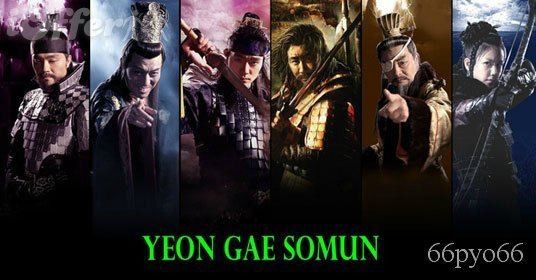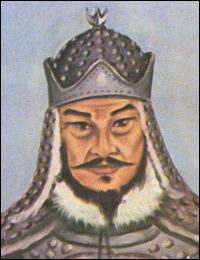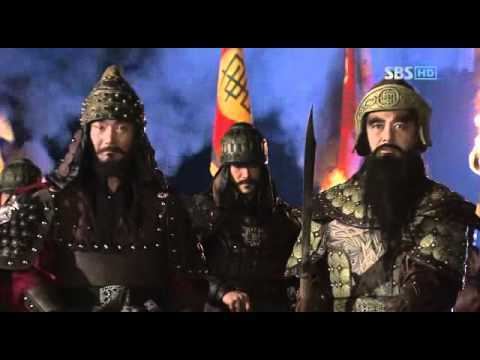Hangul 연개소문 Name Yeon Gaesomun Hanja 淵蓋蘇文 Died 666 AD | McCune–Reischauer Yon Kaesomun | |
 | ||
Similar People Yang Manchun, Eulji Mundeok, Emperor Taizong of Tang, Zhangsun Wuji | ||
Revised Romanization Yeon Gaesomun | ||
Kore dram acilis yeon gaesomun opening
Yeon Gaesomun (603–666) was a powerful military dictator in the waning days of Goguryeo, which was one of the Three Kingdoms of ancient Korea. He is remembered for his numerous successful resistances in military conflicts with Tang China under Emperor Taizong and his son Emperor Gaozong. Emperor Taizong's failure to Yeon Gaesomun was the only defeat that he suffered on the battlefield.
Contents
- Kore dram acilis yeon gaesomun opening
- Korean Superhero Yeon Gaesomuns Flying Sword
- Biography
- Overthrow of the throne
- Wars with China
- Death
- Legends
- Historical depictions
- In popular culture
- Film and television
- Literature
- References

Traditional Korean histories painted Yeon Gaesomun as a despotic leader, whose cruel policies and disobedience to his monarch led to the fall of Goguryeo. However, his achievements in defending Goguryeo against Chinese onslaughts have inspired Korean nationalist historians, most notably the 19th century Korean historian and intellectual Shin Chaeho, to term Yeon Gaesomun the greatest hero in Korean history. Many Korean scholars today echo Shin Chaeho and praise Yeon Gaesomun as a soldier-statesman without equal in Korean history.

Korean Superhero Yeon Gaesomun's Flying Sword
Biography

Yeon Gaesomun was born into the influential and distinguished Yeon family as the first and oldest son of Yeon Taejo, the prime minister (막리지, 莫離支) of Goguryeo during the reigns of King Pyeongwon and King Yeongyang. His grandfather Yeon Ja-yu was also a prime minister.

Information about Yeon Gaesomun comes largely from the Samguk Sagi's biographical accounts of King Yeongnyu, King Bojang, and Yeon Gaesomun himself, and tomb engravings and biographical accounts, from the New Book of Tang, dedicated to his sons Yeon Namsaeng and Yeon Namsan.
Tang Chinese historical records give Yeon Gaesomun's surname as Cheon (泉, Quán in Chinese, meaning "water spring"), because Yeon (淵, Yuān in Chinese, meaning "riverhead") was the given name of Emperor Gaozu (Lǐ Yuān, 李淵), the founding emperor of Tang, and thus subject to the naming taboo by Chinese tradition. Yeon Gaesomun is also sometimes referred to as Gaegeum (개금/蓋金). In the Nihon Shoki, he appears as Iri Kasumi (伊梨柯須彌).
Very little is known of Yeon Gaesomun's early days, until he became the Western Governor (西部大人), where he oversaw the building of the Cheolli Jangseong, a network of military garrisons to defend Liaodong from Tang.
Yeon Gaesomun had at least three sons: (eldest to youngest) Yeon Namsaeng, Yeon Namgeon, and Yeon Namsan.
Overthrow of the throne
In the winter of 642, King Yeongnyu was apprehensive about Yeon Gaesomun and plotted with his other officials to kill him. When Yeon Gaesomun discovered the plot, he arranged a lavish banquet to celebrate his rise to the position of Eastern Governor (东部大人) to which one hundred of the opposing politicians of the nation were invited. Yeon Gaesomun ambushed and killed all one hundred politicians present, and then proceeded to the palace and murdered King Yeongnyu. According to traditional Chinese and Korean sources, Yeon Gaesomun's men dismembered the king's corpse and discarded it without proper ceremony.
After placing King Bojang (r. 642-668),a nephew of King Yeongnyu, on the Goguryeo throne, Yeon Gaesomun appointed himself the Dae Magniji (대막리지, 大莫離支, generalissimo) and assumed absolute de facto control over Goguryeo affairs of state until his death around 666.
Yeon Gaesomun's coup d'etat came as the culmination of a lengthy power struggle between those in the government who favored appeasement toward Tang China and those who advocated military confrontation; Yeon Gaesomun belonged to the hard-liners. Traditional Chinese and Korean historians assumed that Yeon Gaseomun's motive was simply his thirst for power, but many modern Korean historians assert that his motive was to make Goguryeo assume a tougher stance against Tang China, as opposed to King Yeongnyu who submitted to Tang for a peaceful diplomatic relationship. Yeon Gaesomun's role in the murder of King Yeongnyu was taken as the primary pretext for the failed Tang invasion of 645.
Wars with China
The series of wars between Goguryeo and Tang China comprise some of the most important events in the ancient history of Northeast Asia, leading to the Tang-Silla alliance, the ultimate demise of powerful Goguryeo, and the unification of the Korean Peninsula under Silla control. Yeon Gaesomun was a central protagonist in this series of conflicts, as well as its primary cause.
At the outset of his rule, Yeon Gaesomun took a brief conciliatory stance toward Tang China. For instance, he supported Taoism at the expense of Buddhism, and to this effect in 643, sent emissaries to the Tang court requesting Taoist sages, eight of whom were brought to Goguryeo. This gesture is considered by some historians as an effort to pacify Tang and buy time to prepare for the Tang invasion Yeon thought inevitable given his ambitions to annex Silla.
Relations with Tang deteriorated when Goguryeo launched new invasions of Silla. In 645, the first campaign in the Goguryeo–Tang War began and Emperor Taizong's noted military acumen enabled him to conquer a number of major Goguryeo border fortresses.
Eventually, however, Emperor Taizong's invasion was met with two major setbacks. First, his main army was stymied and bogged down for several months at Ansi Fortress due to the resistance of the celebrated commander, Yang Manchun. Second, the elite marine force that he sent to take Pyongyang, Goguryeo's capital, was defeated by Yeon Gaesomun who, according to the Joseon Sanggosa, then immediately marched his legions to relieve Yang Manchun's forces at Ansi Fortress.
Emperor Taizong, caught between Yang Manchun's army in the front and Yeon Gaesomun's counter-attacking forces closing in from behind, as well as suffering from the harsh winter and dangerously low food supplies, was forced to retreat homeward. Before setting off, Emperor Taizong left behind 100 bolts of silk cloth out of respect to Yang Manchun. The retreat was difficult and many of his soldiers died. Emperor Taizong survived and made it back home, but his campaign against Goguryeo was defeated. However, he succeeded in inflicting heavy casualties on Goguryeo. Upon returning home, Emperor Taizong founded the Minzhong Temple, the oldest temple in Beijing, to commemorate his soldiers who died in Goguryeo. He invaded Goguryeo again in 647 and 648, but was defeated both times, and thus was unable to accomplish his ambition of conquering Goguryeo in his lifetime.
Defeating Goguryeo had been an obsession with Emperor Taizong, and after his death in 649, his son Emperor Gaozong continued his ambition. After the Tang-Silla alliance conquered Baekje, Emperor Gaozong invaded Goguryeo in 661 and 662 but was defeated each time. One of Yeon Gaesomun's greatest victories came in 662, when his forces defeated Tang general Pang Xiaotai (龐孝泰) at the Sasu River (蛇水, probably Botong River), slaying him and his 13 sons. Famed Tang general Su Dingfang (蘇定方), who was instrumental in conquering Baekje, was unable to overcome Pyongyang's defenses and was forced to withdraw due to harsh snowstorms. With increasing domestic turmoil in China, Tang was once again forced to retreat.
However, Goguryeo's population and economy were severely damaged due to the long years of continuous warfare. Yeon Gaesomun died in 666 of a natural cause, and Goguryeo was thrown into chaos and further weakened by a succession struggle among his sons and younger brother, with his eldest son defecting to Tang and his younger brother defecting to Silla. Tang mounted a fresh invasion in 667, aided by Silla and the defector Yeon Namsaeng, and was finally able to conquer Goguryeo in 668. However, at least during the rule of Yeon Gaesomun the Tang-Silla alliance was unable to subdue Goguryeo.
Death
The most likely date of Yeon Gaesomun's death is that recorded on the tomb stele of his eldest son Yeon Namsaeng on the twenty-fourth year of the reign of King Bojang (665). However, the Samguk Sagi records the year as 666, and the Nihon Shoki gives the year as the twenty-third year of the reign of King Bojang (664).
Legends
According to a local Chinese legend in the 19th century Funing County Annals (阜宁县志): during a campaign, Emperor Taizong was scouting ahead of his army and was almost captured when he discovered Yeon Gaesomun's encampment and was recognized by the latter, but narrowly escaped by hiding in a decrepit well; later, Emperor Taizong had a pagoda (朦朧塔) erected near the location.
Historical depictions
Tang and Silla sources portrayed Yeon Gaesomun as a brutal and arrogant dictator who carried five swords at a time, and had men prostrate themselves so that he could use their backs to mount and dismount his horse.
In popular culture
Yeon Gaesomun sometimes appears as a door god in Chinese and Taoist temples in partnership with the Chinese general Xue Rengui.
Film and television
Literature
Yeon Gaesomun (under the name Gai Suwen) appears in Peking opera as the archvillain of the famed Tang general Xue Rengui, who rescues Emperor Taizong from Yeon Gaesomun's pursuit.
Yeon Gaesomun appears in numerous classical Chinese literature about Xue Rengui, who rescues Emperor Taizong from certain death at the hands of Yeon Gaesomun himself.
Age of Empires: World Domination, a mobile game produced in collaboration with series owner Microsoft, includes Yeon Gaesomun as a selectable hero of the Korean civilization.
